
The Angolan Armed Forces or FAA is the military of Angola. The FAA consist of the Angolan Army, the Angolan Navy and the National Air Force of Angola. Reported total manpower in 2021 was about 107,000. The FAA is headed by the Chief of the General Staff António Egídio de Sousa Santos since 2018, who reports to the minister of National Defense, currently João Ernesto dos Santos.

The Type A Ko-hyoteki class was a class of Japanese midget submarines (Kō-hyōteki) used during World War II. They had hull numbers but no names. For simplicity, they are most often referred to by the hull number of the mother submarine. Thus, the midget carried by I-16-class submarine was known as I-16's boat, or "I-16tou."

The South African Navy (SA Navy) is the naval warfare branch of the South African National Defence Force.
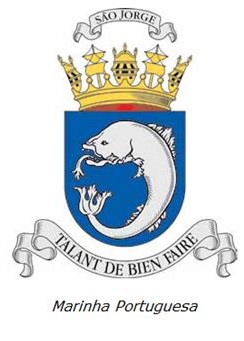
The Portuguese Navy, also known as the Portuguese War Navy or as the Portuguese Armada, is the navy of the Portuguese Armed Forces. Chartered in 1317 by King Dinis of Portugal, it is the oldest continuously serving navy in the world; in 2017, the Portuguese Navy commemorated the 700th anniversary of its official creation.
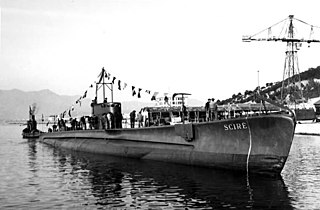
Italian submarine Scirè was an Adua-class submarine, built in the 1930s which served during World War II in the Regia Marina. It was named after a northern region of Ethiopia, at the time part of Italian East Africa.

The Russian commando frogmen, informally called "commando frogmen" in civilian media, are a Russian Naval Spetsnaz unit under operational subordination to the GRU that specialized in amphibious reconnaissance to prepare for amphibious warfare operations, clandestine operation, defense against swimmer incursions, direct action against important strategic or tactical goals, irregular warfare, ISTAR, maritime counterterrorism and hostage rescue, and naval special warfare. It is the special forces unit of the Russian Naval Infantry and is composed of highly trained and elite marines within the Naval Infantry. By virtue of belonging to the Russian Naval Infantry, frogmen fall under the Coastal Troops of the Russian Navy service arm. The Russian Navy proper does not field any special forces or special operations forces. Russian FSB special forces Alpha Group and Vympel also have frogman units in their respective naval components.

From 31 May to 8 June 1942, during World War II, Imperial Japanese Navy submarines made a series of attacks on the Australian cities of Sydney and Newcastle. On the night of 31 May – 1 June, three Ko-hyoteki-class midget submarines, each with a two-member crew, entered Sydney Harbour, avoided the partially constructed Sydney Harbour anti-submarine boom net, and attempted to sink Allied warships. Two of the midget submarines were detected and attacked before they could engage any Allied vessels. The crew of M-14 scuttled their submarine, whilst M-21 was successfully attacked and sunk. The crew of M-21 killed themselves. These submarines were later recovered by the Allies. The third submarine attempted to torpedo the heavy cruiser USS Chicago, but instead sank the converted ferry HMAS Kuttabul, killing 21 sailors. This midget submarine's fate was unknown until 2006, when amateur scuba divers discovered the wreck off Sydney's northern beaches.

Operation Savannah was the South African code name for their military incursion into Angola in 1975–1976. It was part of the South African Border War and arose due to the Angolan War of Independence. The operation also materially influenced the subsequent Angolan Civil War. South African forces invaded deep into Angola with the objective of driving the MPLA, Soviet and Cuban forces out of southern Angola so as to strengthen the position of UNITA, the main opponent of the MPLA and an ally of South Africa.
Operation Daisy was a military operation conducted from November 1–20, 1981 by the South African Defence Force and South West African Territorial Force (SWATF) in Angola during the South African Border War and Angolan Civil War. This conflict was sparked when the South African Defence Force decided to try to halt the regroup of the active military branch of SWAPO, also known as the People's Liberation Army of Namibia.

I-30 was a Type B1 submarine of the Imperial Japanese Navy during World War II. After operating in the Indian Ocean she participated in a Yanagi mission, aimed at connecting Japan and Nazi Germany by submarine. She was the first Japanese submarine to reach Europe, arriving at Lorient, France in August 1942. I-30 returned to Singapore loaded with military technology and information, but hit a mine outside the harbour and sank. Only part of her cargo was salvaged.
German submarine U-735 was a Type VIIC U-boat built for Nazi Germany's Kriegsmarine for service during World War II.
I-124, originally named Submarine Minelayer No. 52 and then named I-24 from before her launch until June 1938, was an I-121-class submarine of the Imperial Japanese Navy that served during the Second Sino-Japanese War and World War II. During the latter conflict, she operated in support of the Japanese invasion of the Philippines and was sunk during anti-shipping operations off Australia in January 1942.
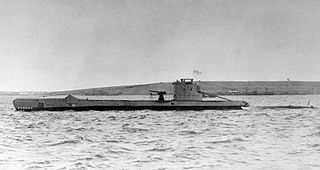
HMS Urge was a British U-class submarine, of the second group of that class, built by Vickers Armstrong, Barrow-in-Furness. She was laid down on 30 October 1939, and was commissioned on 12 December 1940. From 1941 to 1942 she formed part of the 10th Submarine Flotilla based in Malta and spent most of her career operating in the Mediterranean, where she damaged and sank enemy warships and merchant vessels and undertook both SBS and SIS special operations. She was commanded by Lieutenant-Commander Edward Philip Tomkinson, DSO, RN. She was lost with all hands and a number of naval passengers on 27 April 1942 after striking a German mine off Malta.
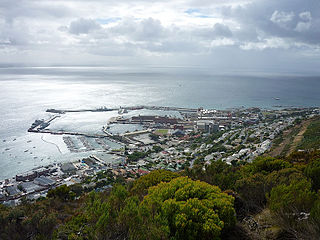
South Africa currently does not have a marine corps, though in the past it did. It was originally set up as a sub-branch of the South African Navy during the apartheid era, with the primary purpose of protecting the country's harbours (1951-1955). Then it was recreated in 1979 during the South African Border War as 1 Marine Brigade with the aim of serving as marine infantry (1979-1990). Today, the SAN Maritime Reaction Squadron is the closest analogue to a marine corps South Africa has.
Operation Kerslig was a South African Defence Force special forces raid on an oil refinery outside Luanda, Angola. The raid took place on 30 November 1981 by members of the 1 and 4 Reconnaissance Regiments.
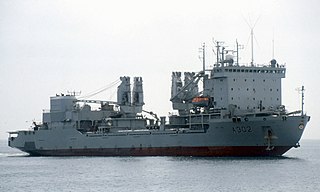
SAS Outeniqua was a sealift and replenishment ship operated by the South African Navy between 1993 and 2004. During her operational career she conducted several "flag-showing" cruises to African ports and provided support for South Africa's Antarctic research program. Outeniqua was also the venue for unsuccessful peace talks between Zaire's President Mobuto Sese Seko and rebel leader Laurent Kabila in May 1997.
The following index is provided as an overview of and topical guide to Wikipedia's articles on recreational dive sites. The level of coverage may vary:
M24 Japanese Midget Submarine wreck site is a heritage-listed former midget submarine and now archaeological site located in unincorporated waters off Sydney's Northern Beaches in New South Wales, Australia. The Ko-hyoteki-class midget submarine was designed by the Imperial Japanese Navy and built from 1941 to 1942 by Kure Naval Yard or Ourazaki Naval Yard. The site was added to the New South Wales State Heritage Register on 7 December 2007.

Recreational dive sites are specific places that recreational scuba divers go to enjoy the underwater environment or for training purposes. They include technical diving sites beyond the range generally accepted for recreational diving. In this context all diving done for recreational purposes is included. Professional diving tends to be done where the job is, and with the exception of diver training and leading groups of recreational divers, does not generally occur at specific sites chosen for their easy access, pleasant conditions or interesting features.
Operation Lark was two special forces naval operations in 1978 conducted by members of the South African Navy (SADF), 4 Reconnaissance Regiment and Rhodesian SAS during the South African Border War. Its objective was the assassination of Robert Mugabe at his residence in Maputo, Mozambique.













